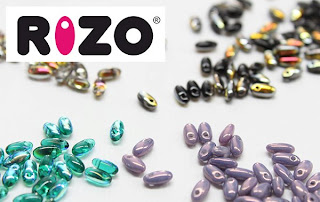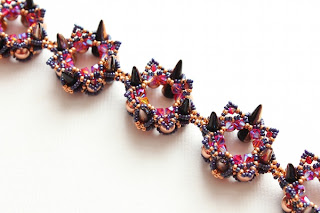
... Dr. Leo Baekeland turned his mind to the problem of making a replacement for shellac. Up till then, shellac - used to finish furniture - was made from the Lac beetle - and, he reasoned, there had to be a better way. As with many revolutionary inventions - what he came up with was not what he had intended, but instead, was no less than the beginning of a modern revolution in materials - the invention of the first inexpensive, nonflammable, versatile, synthetic resin - or, as we call it today - plastic.

Bakelite - as it was called - the material of a 1,000 uses - changed the world. It's properties of being heat-resistant and non-conductive made it a big hit for industrial use, and war-time shortages furthered it's use to replace hard-to-get materials.
In the late 20's - the American Catalin Corporation took over the patents for Bakelite, and changed up the manufacturing process, and doing so, invented new colours. By the 30's - this new Catalin Bakelite was in use in jewelry making for beads, bangles, earrings and rings.

Fast forward to the 90's - and a passion for retro and antique items sweeps the nation. Unlike modern plastics, it was often carved into shape instead of being molded - and the classic workmanship, along with the heavy feel, durability (it is as hard as brass), distinctive "clunk" when struck, and age-created patina turns Catalin Bakelite into a hot collectible. The genuine vintage article soars in price - until, at the top of the market - vintage "Philadelphia" style bracelets are selling for $4,000.
Prices have settled back to more reasonable levels now - and although bakelite is still in production

for some uses (mostly industrial) - recently - a large stash of genuine vintage, genuine Bakelite jewelry components have come to light.
And we have some of it for you! These are the real deal - vintage Bakelite beads, plus some buckle-like things and other assorted parts ... . It's fun to incorporate a bit of history into your new creations, and if you are as geeky as me, as soon as someone asks - you are off on a detailed explanation of why this bead or that is so cool and this is interesting because, ... and so on. Remember, geek is the new chic and it's ok to actually do that now!
Plus - I think it looks awesome with leather!
![s36458 Two Part Epoxy Clay - [100 grams] Ceralun Ceramic Epoxy Composite - Pearl Silk (Pack)](https://lh3.googleusercontent.com/blogger_img_proxy/AEn0k_to2fXHcNMpLrbHA6EfxMkLd0o6OrtKEQ-EHmaMx2vR6EXa_FSo2-z2qAFB6zjjqTmhLnwe7QWzNB16Ay7Mj1N8W2kyHa7lkNFrHA=s0-d)
If Bakelite is something old - then on the "something new" front - we have some two-part epoxy clay. Hah - you might scoff - that's not new! Fair enough - but this is Swarovski's own house-brand of epoxy clay. This is the clay that is used to hold stones in the Swarovski-covered items like the Euro-style charm beads and other jewelry items.
It is not packaged in a charming, consumer-friendly package, with optional extras and detailed instructions and suggested projects.
What it is, however, is fabulous. The colours, while limited, are gorgeous, and beautifully complement Swarovski's stones. I have personally tried the Gold and found it to be a very pleasing match to brass and gold metal, and the silver as well. I wouldn't say that they exactly match the colour of the metal - but they work nicely with it. It has a bit of a shimmer to it, as if something sparkly is already mixed into the clay - and in some colours - the resin and the hardener are two different colours, instead of the colour + grey that many of the other epoxy clays are.
So - if you have tried other epoxy clays - I recommend giving this one a try.
Ceralun Ceramic Epoxy Composite.
If you have not tried an epoxy clay before - there is no particular reason not to start with this one. Cut off an equal amount from each "log" of the clay and hardener. Knead the two pieces together (I suggest wearing gloves, i.e. latex or natril gloves) until they are evenly combined - takes about 5 minutes. It is inherently sticky - so you can

mold it, and stick it onto a base or background, and then embellish by pressing crystals, beads, or what have you into the surface. You have about 60 minutes before it is too hard to do stick anything to. Then let it cure for about 24 hours. That's all there is to it - no firing, no nasty smells, no messy clean up.

Oh, and I guess you'll be wanted some sort of base to actually stick this stuff to. How about a ring? Like these awesome cast, sized rings. Brass and Silver-tone - hefty and solid-feeling. These rings are handsome and just plain yummy! In two styles and sizes from 6 to 13!

If a bangle bracelet is what floats your boat instead - we have these great, new channel bangle bracelets.
Find these and
other clay-able bases here!
And finally, if that was not enough wonder and awe for you, we are pleased to present you with ... drumroll please ... Dark Neon. Faster than a speeding puppy, more powerful than a bowl of prunes, able to thread bead-needles in a single pass - it's Dark Neon.

No - seriously - if Neon colours were this summer's thing - and I think they were more of a fling than a thing - then hot to trot for fall are these stunning
Jewel Tone Dark Neon colours. Four electric shades that easy to be seduced by - Vivacious Purple, Emerald, Mykonos Blue and Acai. If you can't decide, you can alway get the mix!
Well, that about wraps it up for this week. Remember to have fun and play with your beads!































